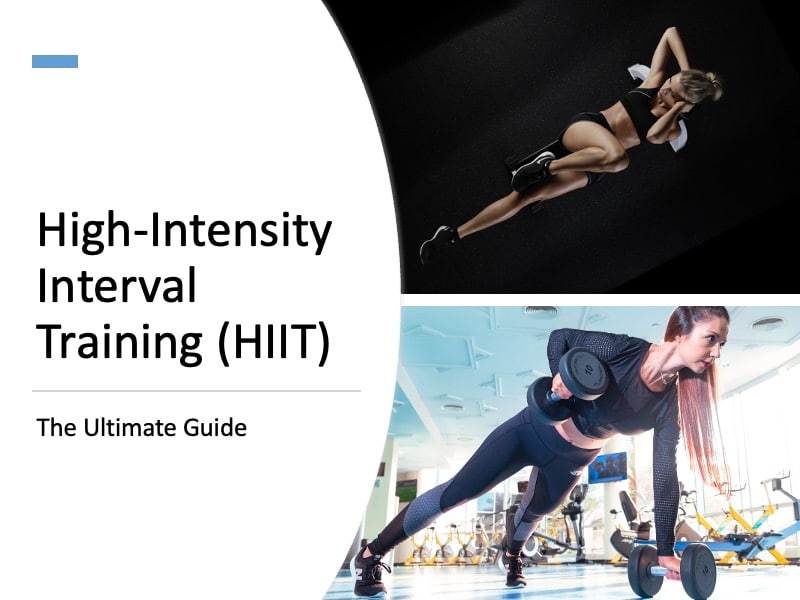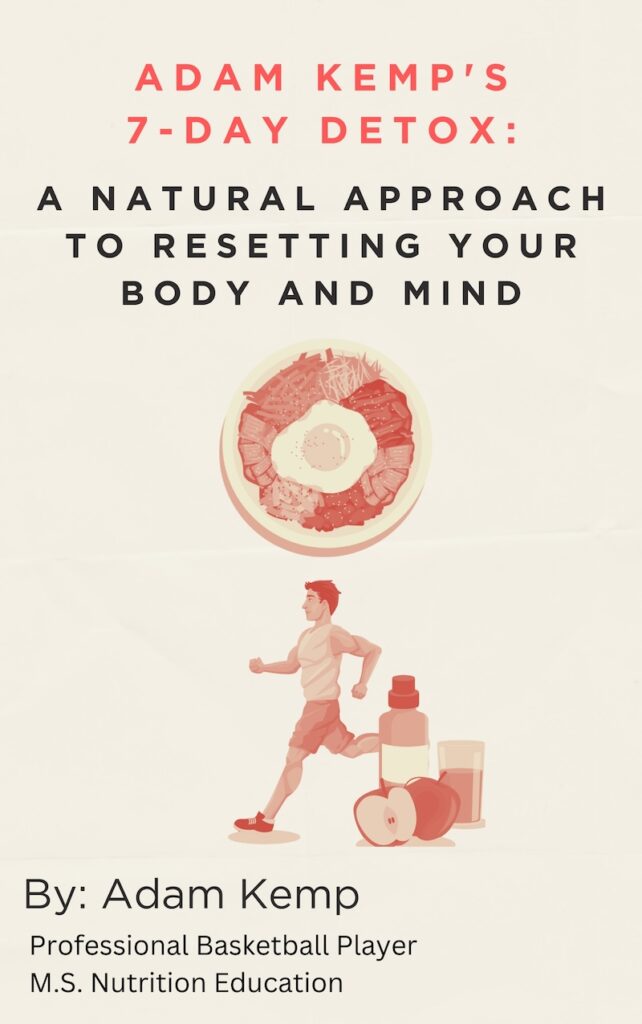High-Intensity Interval Training (HIIT): Benefits, How to Do
High-Intensity Interval Training (HIIT) has revolutionized fitness with its ability to deliver powerful results in less time.
This training method alternates short bursts of intense exercise with periods of rest or low-intensity recovery, making it a versatile and efficient workout for fat loss, cardiovascular health, and athletic performance.
As a professional basketball player, High-Intensity Interval Training (HIIT) has been an invaluable part of my fitness routine throughout my career.
The demands of basketball require more than just traditional cardio or running; the sport demands explosive strength, quick bursts of energy, and sustained endurance over the course of a game.
HIIT workouts mimic these unique physical challenges, making it an ideal training method for developing basketball-specific endurance and functional strength.
This type of training is not only effective for basketball but is also essential for athletes in various sports where agility, power, and stamina are critical.
Beyond athletic performance, HIIT is one of the best ways to sculpt an aesthetic physique, enhance cardiovascular health, and improve overall well-being.
Its versatility, efficiency, and effectiveness make it a cornerstone for anyone looking to elevate their fitness—whether you’re an athlete aiming to dominate your sport or simply seeking better health and a stronger body.
What is High-Intensity Interval Training (HIIT)?
Although there is no specific definition for high-intensity interval training, research indicates that the most commonly known understanding of HIIT is:
Workouts that involve short, intense bouts of exercise followed by recovery periods. These intervals push your heart rate to 80-90% of its maximum, which triggers a robust cardiovascular and metabolic response.
Unlike steady-state cardio, HIIT creates an afterburn effect (excess post-exercise oxygen consumption, or EPOC), allowing your body to burn calories long after the workout ends.
Metabolic Conditioning vs. HIIT
Metabolic Conditioning (MetCon) workouts and High-Intensity Interval Training (HIIT) are both high-intensity workout styles that aim to improve the body’s energy pathways, burn calories, and enhance overall fitness.
However, there are some differences between the two.
- Metabolic Conditioning is a broad term that can encompass a variety of workouts that use exercises to improve the body’s immediate, intermediate, and long-term energy pathways.
- Metabolic Conditioning workouts can take different forms, such as circuits, spin classes, and Tabata workouts, and are typically done at a high intensity for longer periods, usually 10 minutes or more.
The goal is to condition the body to become more efficient in using energy.
In contrast, HIIT workouts are more narrowly defined and are done at the highest energy level possible with predetermined rest intervals throughout.
- HIIT workouts can be circuits or MetCons, but they typically involve short bursts of intense exercise followed by brief rest or recovery periods.
- HIIT workouts are designed to maximize the body’s calorie burn, even after the workout is over, and to improve aerobic capacity.
Both Metabolic Conditioning and HIIT workouts offer significant health benefits.
- MetCon improves the body’s efficiency in using energy, burns calories, increases aerobic capacity, and can help build lean muscle mass and reduce body fat.
- HIIT workouts also burn calories, increase aerobic capacity, and can help build lean muscle mass, but they are more specifically focused on calorie burn and improving the body’s ability to recover from intense exercise.
MetCon and HIIT are both effective high-intensity workout styles that offer significant health benefits.
While there are some differences, both can be useful for improving overall fitness, burning calories, and building lean muscle mass.
Benefits of HIIT Workouts
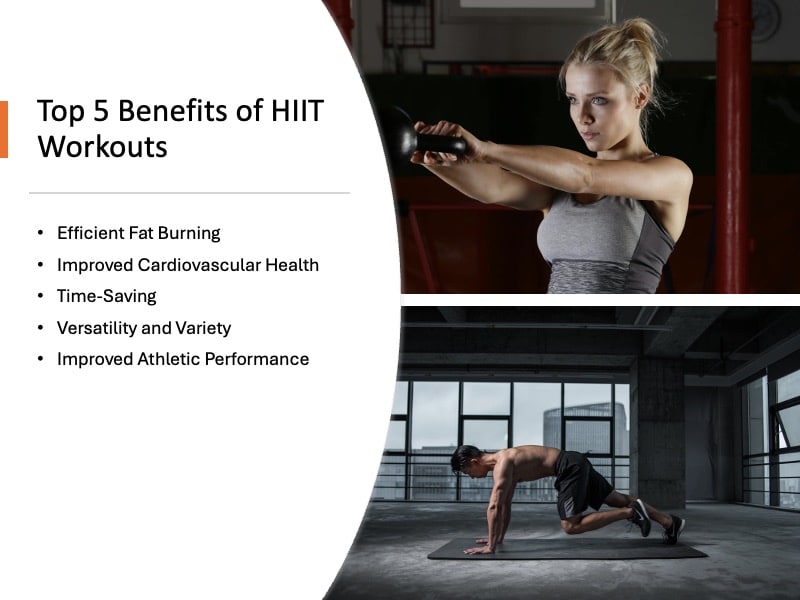
The benefits of high-intensity interval training workouts extend far beyond just burning calories.
HIIT is a powerhouse method for improving athletic performance, boosting cardiovascular health, and achieving a lean, toned physique.
By combining short bursts of intense effort with strategic recovery periods, HIIT maximizes efficiency, allowing you to accomplish more in less time.
Whether your goal is to excel in sports, shed fat, or enhance your overall fitness, HIIT delivers unmatched results that support strength, endurance, and long-term health.
Efficient Fat Burning
High-intensity interval training is one of the most effective training methods for burning fat and improving body composition.
Its unique structure, which includes alternating maximum effort with strategic rest, creates a powerful physiological response that enhances fat loss without compromising muscle mass.
Unlike steady-state cardio, HIIT activates the afterburn effect, also known as excess post-exercise oxygen consumption (EPOC). This metabolic state keeps your body burning calories at an elevated rate for up to 24 hours after the workout ends.
Studies have shown that high-intensity interval training (HIIT) significantly increases fat oxidation and metabolic rate compared to moderate-intensity continuous training (Keating et al., 2017).
Despite being a short workout, high-intensity interval training still puts enormous pressure on your body, resulting in increased calorie burning and fat loss.
For example, a 2007 study published in the Journal of Applied Physiology found that 7 sessions of HIIT over 2 weeks resulted in a 30% increase in fat oxidation, meaning you burn more fat with high-intensity interval training.
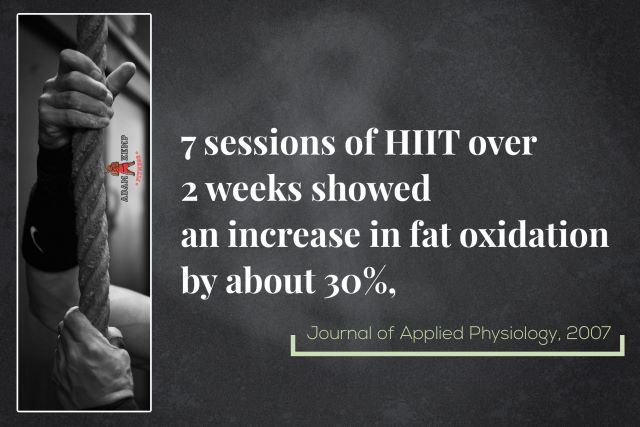
The intense work periods spike your heart rate and stimulate key fat-burning hormones like epinephrine and growth hormone, which promote lipolysis (the breakdown of stored fat for energy).
In addition to targeting visceral fat, HIIT supports lean muscle retention by engaging fast-twitch muscle fibers, which are typically underutilized in low-intensity cardio.
As, another example, a 2015 study published in Obesity Reviews found that HIIT programs are more effective in lowering fasting glucose levels and improving metabolic health in individuals with Type 2 diabetes.
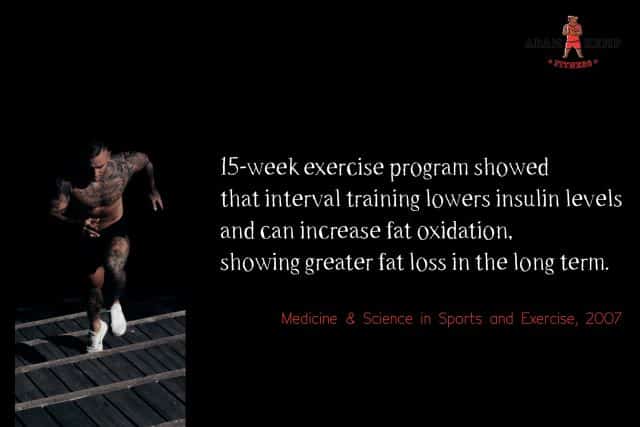
This combination makes HIIT especially effective for redefining your physique and helping you burn fat while preserving or even building muscle.
Key ways HIIT helps you burn fat include:
- Increased Caloric Expenditure: HIIT burns more calories per minute than traditional cardio.
- Boosted Metabolism: Elevated post-workout oxygen demand increases resting energy expenditure.
- Fat-Specific Targeting: Research suggests HIIT can reduce abdominal and visceral fat more effectively than steady-state cardio (Wewege et al., 2017).
- Muscle-Sparing Effects: Engages high-threshold motor units to promote muscle preservation and growth.
For athletes and everyday exercisers alike, this means HIIT offers both performance and aesthetic advantages, improving conditioning while reshaping the body faster than conventional cardio methods.s muscle mass, allowing you to lose fat while maintaining a strong, lean physique.
Improved Cardiovascular Health
Studies shows that high-intensity exercises significantly increase heart rate and oxygen consumption, strengthening the heart and vascular system (Batacan et al., 2017).
- Reduced Disease Risk: HIIT lowers the risk of cardiovascular disease, stroke, and hypertension by improving arterial flexibility and reducing blood pressure.
- Improved VO₂ Max: HIIT improves heart health by increasing VO2 max (maximal oxygen uptake) and reducing blood pressure (Gibala et al., 2012).
Additionally, research shows that high-intensity exercise can increase heart rate more quickly than lower-intensity exercise, which can help strengthen the heart and improve its ability to function effectively (Yue et al., 2022).
The strenuous effects of HIIT appear safe when HIIT workouts are conducted properly, and HIIT can reduce the risk of heart disease, stroke, and other health conditions associated with poor cardiovascular health.
This improvement translates to better stamina, endurance, and overall heart health. HIIT also reduces blood pressure, cholesterol levels, and resting heart rate, making it a great option for individuals aiming to protect and strengthen their cardiovascular system.
For athletes, this means lasting energy and reduced fatigue during high-demand activities.
Time-Saving
One of the standout benefits of HIIT is its efficiency. A HIIT workout typically lasts just 15-30 minutes but delivers the same, if not greater, benefits as an hour of traditional steady-state cardio.
This makes HIIT ideal for busy schedules, ensuring you can stay consistent with your fitness goals without sacrificing time.
For athletes balancing training, recovery, and life commitments, HIIT offers an optimal way to improve conditioning in a fraction of the time.
Versatility and Variety
The adaptability of HIIT is one of its most attractive features.
You can perform HIIT using bodyweight exercises like burpees or jump squats, cycling sprints, running intervals, or resistance-based movements with kettlebells and resistance bands.
- This versatility allows you to customize workouts to your fitness level, goals, and preferences.
- The variety also helps prevent boredom and ensures you stay motivated to continue training consistently.
Athletes benefit from the ability to tailor HIIT to their sport, improving specific performance metrics like speed, power, and agility.
Improved Athletic Performance
High-intensity interval training is one of the most effective ways to improve athletic performance because it mimics the demands of many sports, which require bursts of intense effort followed by short recovery periods.
HIIT enhances speed, power, and endurance by targeting fast-twitch muscle fibers and increasing anaerobic capacity, allowing athletes to perform at high intensities for longer durations.
HIIT leg workouts, for example, are excellent if you want to increase your vertical jump.
Additionally, it strengthens the cardiovascular system, improving recovery times between efforts during games or matches.
Beyond the physical benefits, HIIT builds mental toughness, preparing athletes to maintain focus and resilience under pressure.
This makes it a valuable tool for athletes looking to gain a competitive edge.
A Few of the Best HIIT Workouts
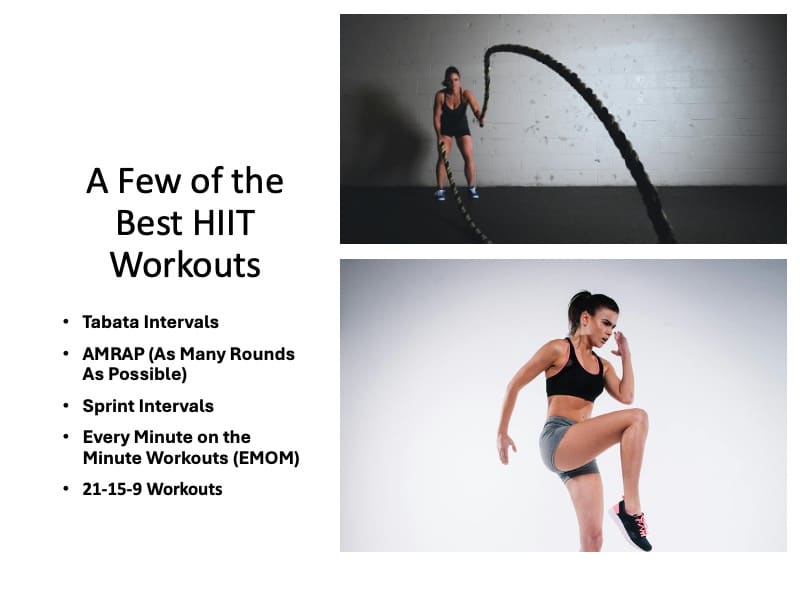
High-intensity interval training is incredibly versatile, offering a variety of workout styles that can suit different fitness levels and goals.
The following popular HIIT formats are effective and easy to adapt, making them accessible whether you’re a seasoned athlete or just starting your fitness journey.
These workouts combine efficiency and intensity, helping you maximize results in minimal time.
Tabata Intervals
In my opinion, the best HIIT workout program is the Tabata workout.
- Structure: The Tabata protocol is a classic high-intensity interval training workout format that alternates 20 seconds of all-out effort with 10 seconds of rest, repeated for eight rounds, totaling just 4 minutes. It was developed by Dr. Izumi Tabata and his colleagues at the National Institute of Fitness and Sports in Japan (Viana et al., 2019).
- Example: This protocol works well with movements like bodyweight squats, burpees, or cycling sprints.
- Why It Works: Tabata is perfect for those who want an intense, fast-paced workout. Its structure pushes your heart rate to near-maximal levels, improving both anaerobic and aerobic fitness. Despite its short duration, it delivers significant fat-burning and endurance-building benefits. For beginners, adjusting the work-to-rest ratio to 15:15 can help ease the intensity.
You can do the Tabata interval protocol with a variety of different exercises. Here are some good options:
- Air Squats
- Jumping jacks
- Burpees
- Mountain climbers
- Squat jumps
- Push-ups
- Plank jacks
- Sit-ups
- Jumping lunges
- Box jumps
- Kettlebell swings
Additionally, you can use a piece of fitness equipment, like battle ropes, a stationary bike, or an ERG rowing machine.
You do one exercise for the entir
AMRAP (As Many Rounds As Possible)
- Structure: AMRAP involves completing as many rounds of a set circuit as possible within a specific timeframe, such as 10 or 20 minutes.
- Example: A simple AMRAP workout might include 10 push-ups, 15 squats, and 20 mountain climbers.
- Why It Works: AMRAP is great for building muscular endurance and cardiovascular fitness while encouraging participants to push their limits. The time-based structure also makes it easy to track progress by counting how many rounds you complete. This format is highly customizable, allowing you to adjust exercises or time limits to suit your fitness level.
Sprint Intervals
- Structure: Sprint intervals involve short bursts of maximum sprinting effort, such as 30 seconds, followed by a longer recovery period, such as 90 seconds of walking. This cycle is repeated for 10-15 minutes.
- Example: A HIIT sprint workout might include sprinting on a treadmill, track, or open field, with walking or light jogging as the recovery phase.
- Why It Works: Sprint intervals are ideal for developing explosive power and speed, which are critical for sports and athletic performance. The recovery periods allow your heart rate to drop, preparing you for the next burst of intense effort. These intervals are particularly effective for torching calories and improving anaerobic capacity.
EMOM (Every Minute on the Minute)
- Structure: In EMOM workouts, you perform a specific number of repetitions of an exercise at the start of every minute, using the remaining time to rest.
- Example: Perform 10 kettlebell swings, then rest for the remainder of the minute. Start the next set at the beginning of the next minute.
- Why It Works: EMOMs are an excellent way to build strength, power, and endurance. They maintain intensity while providing structured rest periods. The format ensures consistent effort, making it a suitable choice for both beginners and advanced exercisers. You can mix and match exercises (e.g., squats, push-ups, or deadlifts) to target different muscle groups within the same workout.
21-15-9 Workouts
- Structure: The 21-15-9 workout is a high-intensity format that combines strength and conditioning exercises in descending rep schemes to challenge your muscles and cardiovascular system. This popular structure pushes you to complete 21 reps of two or three exercises, then 15 reps, and finally 9 reps as fast as possible while maintaining good form.
- Example: A classic 21-15-9 workout might include push-ups, air squats, and kettlebell swings. For a more advanced version, you could pair deadlifts and handstand push-ups.
- Why It Works: The descending rep structure is both physically and mentally motivating. Starting with a high rep count challenges your endurance and strength, while the decreasing reps allow you to maintain intensity as fatigue sets in. This format is highly effective for improving muscular endurance, building strength, and enhancing metabolic conditioning.
Who is HIIT Best For?
HIIT is best for:
- Busy Individuals: Those seeking time-efficient workouts.
- Fat Loss Goals: People aiming to reduce body fat while preserving lean muscle.
- Athletes: HIIT enhances speed, endurance, and agility.
- Cardiovascular Health Seekers: It improves heart health in a shorter time than steady-state cardio.
How to Do HIIT Safely: A Beginner’s Guide to High-Intensity Interval Training
High-Intensity Interval Training is incredibly effective, but it also places significant demands on your body.
To get the most out of your workouts and avoid unnecessary strain or injury, it’s crucial to approach HIIT with a well-structured plan.
These safety strategies are applicable to both beginners and experienced exercisers.
Make Sure You are Medically Ready
If you’re new to exercise, returning after an injury, or managing a chronic condition (like asthma, heart disease, or joint issues), consult your healthcare provider before beginning HIIT.
The intensity of this training style may not be appropriate for everyone without proper guidance.
Prioritize a Full Warm-Up
Jumping into explosive movement without preparation is a recipe for injury.
Spend 5–10 minutes performing dynamic stretches and light cardio, such as arm swings, leg swings, bodyweight lunges, inchworms, or light jogging.
A thorough dynamic warm-up increases muscle temperature, joint mobility, and neurological readiness for high-intensity efforts.
Choose the Right Exercises
Select exercises that match your current fitness level and minimize injury risk. Start with movements you can perform with excellent form, even under fatigue.
Low-impact options include marching in place or cycling intervals.
Moderate options include mountain climbers and push-ups, while advanced options include burpees and kettlebell swings.
Avoid high-skill or heavy-load movements unless you’re well-trained.
To unlock the benefits of HIIT safely, start slow, listen to your body, and build gradually. Focus on quality movement, structured intervals, and adequate rest.
With this foundation, HIIT can become one of the most powerful tools in your fitness arsenal, boosting strength, endurance, and fat loss while minimizing the risk of injury.
Start with Conservative Intervals
Begin with shorter high-intensity efforts followed by longer rest periods to build tolerance.
For example, perform 20–30 seconds of effort at 80–90% of your maximum intensity, followed by 40–60 seconds of light recovery such as walking or slow pedaling.
Start with 6–10 total intervals and progress gradually.
Use the Right Work-to-Rest Ratio
The work-to-rest ratio controls the difficulty of the workout.
Beginners should start with a 1:2 ratio, such as 30 seconds of work followed by 60 seconds of rest.
Intermediate individuals can use a 1:1 ratio, and advanced trainees may progress to 2:1 or higher ratios.
Always prioritize form over speed or intensity.
Monitor Intensity and Heart Rate
Aim for 80–90% of your maximum heart rate during intense intervals. You can estimate your max heart rate with the formula: 220 minus your age.
Using a heart rate monitor or fitness tracker helps ensure you’re training in the right zone without overexerting.
Limit Frequency to Allow Recovery
Since HIIT stresses both the muscular and cardiovascular systems, it should be limited to 2–4 sessions per week.
This enables proper recovery and helps prevent overtraining, burnout, and injury.
Cool Down and Stretch
End every session with 5–10 minutes of light aerobic movement followed by static stretching.
Focus on the muscle groups you just trained, such as your quads, glutes, hamstrings, and shoulders, to support recovery and flexibility.
Tips for Maximizing HIIT Results
HIIT is a powerful training method, but to achieve optimal results, you need a strategic approach.
The following tips will help you make the most of your HIIT workouts, ensuring consistent progress, improved performance, and reduced risk of injury.
1.) Stay Consistent
Consistency is key to reaping the full benefits of HIIT.
Incorporating 2-4 HIIT sessions into your weekly workout routine allows your body to adapt and improve over time.
The explosive nature of HIIT builds strength, endurance, and cardiovascular health, but these results come from steady practice.
Consistency also helps establish HIIT as a habit, making it easier to maintain long-term fitness goals.
2.) Track Progress
Tracking your progress is essential for staying motivated and assessing the effectiveness of your workouts.
Use a fitness tracker or app to monitor metrics like heart rate, calories burned, and VO2 max improvements.
These tools provide valuable insights into your fitness journey and help you identify areas for improvement.
Keeping a workout log book to record times, intervals, and personal bests can also help keep you focused and motivated.
3.) Fuel Your Body
HIIT requires high energy and places significant demands on your muscles and cardiovascular system.
To perform at your best, ensure you’re eating a balanced diet rich in protein, healthy fats, and complex carbohydrates.
Proper hydration before, during, and after your workout is equally critical for maintaining performance and aiding recovery.
Consider pre-workout snacks, like a banana or protein shake, to fuel your workout, and post-workout meals to replenish energy stores and support muscle repair.
4.) Mix It Up
One of the greatest advantages of HIIT is its versatility, so take advantage by varying your workouts.
Alternate between sprint intervals, bodyweight circuits, kettlebell exercises, or Tabata-style training to keep your body guessing and prevent plateaus.
Mixing it up not only improves physical adaptability but also keeps your workouts engaging and fun.
Tailor your routines to align with specific goals, whether you’re aiming to improve agility, build strength, or enhance endurance.
Final Thoughts: Is High-Intensity Interval Training Good for You?
High-Intensity Interval Training is more than just a time-saving workout, it’s a scientifically supported method for improving physical performance, metabolic health, and body composition.
Whether you’re an athlete aiming to gain a competitive edge or someone with a busy schedule looking to maximize your training in minimal time, HIIT offers proven benefits.
It supports cardiovascular fitness, accelerates fat loss, and builds functional strength, all while preserving lean muscle mass.
From my perspective as a professional basketball player who has made a living out of preparing their body, HIIT has consistently helped me improve game-day conditioning, recover faster, and maintain peak athletic performance.
However, its impact extends beyond sports, as HIIT is equally effective for everyday individuals looking to improve their health, energy, and confidence.
While HIIT isn’t a one-size-fits-all solution, it’s an incredibly powerful tool when performed safely and strategically.
Starting at your own pace and building gradually can help you unlock its full potential, without risking burnout or injury.
If you want a workout that delivers maximum results with minimal time commitment, HIIT is absolutely worth adding to your routine.
Frequently Asked Questions About High-Intensity Interval Training
This website does not provide medical advice. This website site does contain affiliate links, and purchases may earn a commission.
Read my Medical Disclaimer, Review Disclaimer, and Publishing Policies for more details. Use of this site indicates acceptance of these terms.

